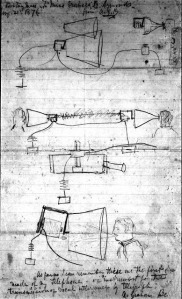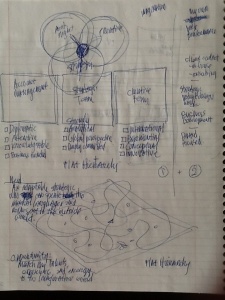Note-taking has many connotations. When you think of note-taking, you might imagine this:

image from http://imet.csus.edu/
Or even this:
As with instruction in other areas, we often bring to note-taking instruction our own experiences, however grand (or limited) they might be. I admit, I am not the best note-taker. It’s not that I don’t take notes. Quite the opposite. I take copious notes, when I’m reading, when I’m taking a class, sometimes even when I’m watching a documentary. Recently, I took two-day intensive childbirth course with my husband. I ended up with pages and pages of notes, many of them nearly verbatim transcriptions of what my instructor said. My problem is not capturing information in my notes. My problem is using my notes as a way to sort through what really matters and what doesn’t. Take, for example, this page from my notes:
You can see I scribbled down essentially everything the instructor said, with a minimal amount of organization or hierarchical categorization.
My husband, James Cockerille, inspires me in many things, including note-taking. He uses a variety of note-taking techniques and strategies. He plans each part of the page wisely. Many of his notebook entries look like little works of art. What’s perhaps most important about his note-taking is that he takes in information, digests it, synthesizes it, and presents it in such a way that it becomes his own, and not just a restatement of what he has heard or read.
Here is a sample from his notes. He took notes digitally at our class, so I snapped these from one of his notebooks, but they provide a sense of the way he thinks:
Establishing a note-taking curriculum can be a powerful way to encourage deeper understanding about a topic, synthesizing across one text and/or several texts, and growing ideas about information. Here are some considerations for getting started.
Establishing a Baseline: Note-Taking Assessment
The best instruction starts with meeting kids where they are, and instruction in note-taking is no exception. As a way to determine what your students already know about note-taking, it is helpful to give them an informal assessment toward the start of the year. First, choose a passage – even a couple of paragraphs will do. You might want to choose a passage on a topic you plan to study, but this is not necessary, though of course it makes sense to choose a passage in the genre kids will mostly be reading across the year in your class (expository nonfiction, i.e.). What is most important is that you choose a passage that kids can read with a high level of accuracy, because, of course, it will be difficult to assess what kids know about note-taking if they can’t read the text you give them. You may want to say something like, “Read the following excerpt. Take notes in the best way you know how so that you understand the information and ideas in the text.”
If your class is anything like mine, you might notice some common note-taker archetypes:
- Minimalist note-takers: Kids who jot down only a few phrases and facts
- Partial note-takers: Kids who take thorough notes on some portions of the texts but not others
- Kitchen-sink note-takers: Kids who jot down anything and everything
- Personal reflection note-takers: Kids whose notes are only loosely based on the text and veer widely into the realm of their own thoughts about the topic (Note: some reacting to the text is wonderful, but note-takers should also be sure to capture the big ideas from the text itself.)
In addition to paying attention to the content of your students’ notes, it is helpful to also pay attention to the structure. Most students without a great deal of experience with kinds of note-taking will default to making lists or writing in paragraphs, often copying from the text, sometimes word for word. While these forms of note-taking certainly have their place, there are a myriad of ways to teach students to take notes that can support synthesis, analysis, and finally, true ownership of the content.
Sharing a Vision: Setting Goals and Defining Progress
As a way to set a vision right from the start for what good note-taking looks like, study some examples of notes that exemplify the kind you hope your students will be able to create by the end of the year. Many wonderful examples can be found online, done by famous note-takers, such as Leonardo Da Vinci and Ben Franklin. It is great fun to study these examples as a way to launch note-taking work. However, to set a vision and goals, it makes sense to stick with note-taking samples that are within reach of those your students can create. The below excerpt from Alexander Graham Bell’s notes is an example that may be somewhat more attainable.

from alexandergrahambell.org
Of course, you can also use samples from previous years, or your own note-taking samples. In fact, the latter work very well because you can write and show the exact kinds of notes you hope your students will create.
My students and I studied some sample notes I had collected from previous years, as well as some that I had created for the occasion. Together, we identified four note-taking lenses that would use to set goals:
- Understanding
- Choosing Kinds
- Ideas
- Neatness and Organization
Of course, I did plenty of heavy-handed guiding to nudge students towards these categories. (Credit note: I leaned heavily on thinking that came out of a group on note-taking I was in with the brilliant Kate Roberts, Chris Lehman, Audra Robb, and Brooke Geller. For great note-taking tips, see Chris’s inspiring book Energize Research Reading and Writing.)
Next, we made a rubric that students could use to assess their own note-taking. This is a first-draft of the rubric, and I expect that it will continue to evolve as the year progresses.
Launching: Starting with a Strategy with a Powerful Impact
In note-taking, as in many things, it is highly motivating for kids to feel they are making tangible progress right away. There are a few note-taking methods that have a huge impact on the quality of kids’ notes (and thinking!). One such method, encouraged by Kathleen Tolan and TCRWP colleagues as a way to launch content area note-taking, is sketching. In Unit One, Grade 4 of TCRWP’s content area curriculum, currently available to affiliated schools, they write: “When students translate words into images, they are forced to monitor their own understanding and actively process the information they are learning, versus copying down words verbatim without processing them.”
One of the very first teaching points in your note-taking curriculum can be that note-takers use sketch notes as a way to hold on to ideas or images. Demonstrate with a read aloud or shared text how you use sketches to envision descriptions, to understand a process, or to remember lists of information. Then, send students off to try this work as they read. You might want to consider having them revise the notes they took in the earlier assessment, translating these notes into sketches. Then, have them compare the two versions of notes to consider ways in which sketching helped them to understand the text or grow ideas.
As a way to begin thinking about your own note-taking curriculum, you may want to study yourself as a note-taker. Do you typically default to one way of taking notes? How do you use your notes after a learning experience as a way to make meaning?
Watch this space for more on note-taking. I would love to hear your realizations about note-taking as the year progresses.



